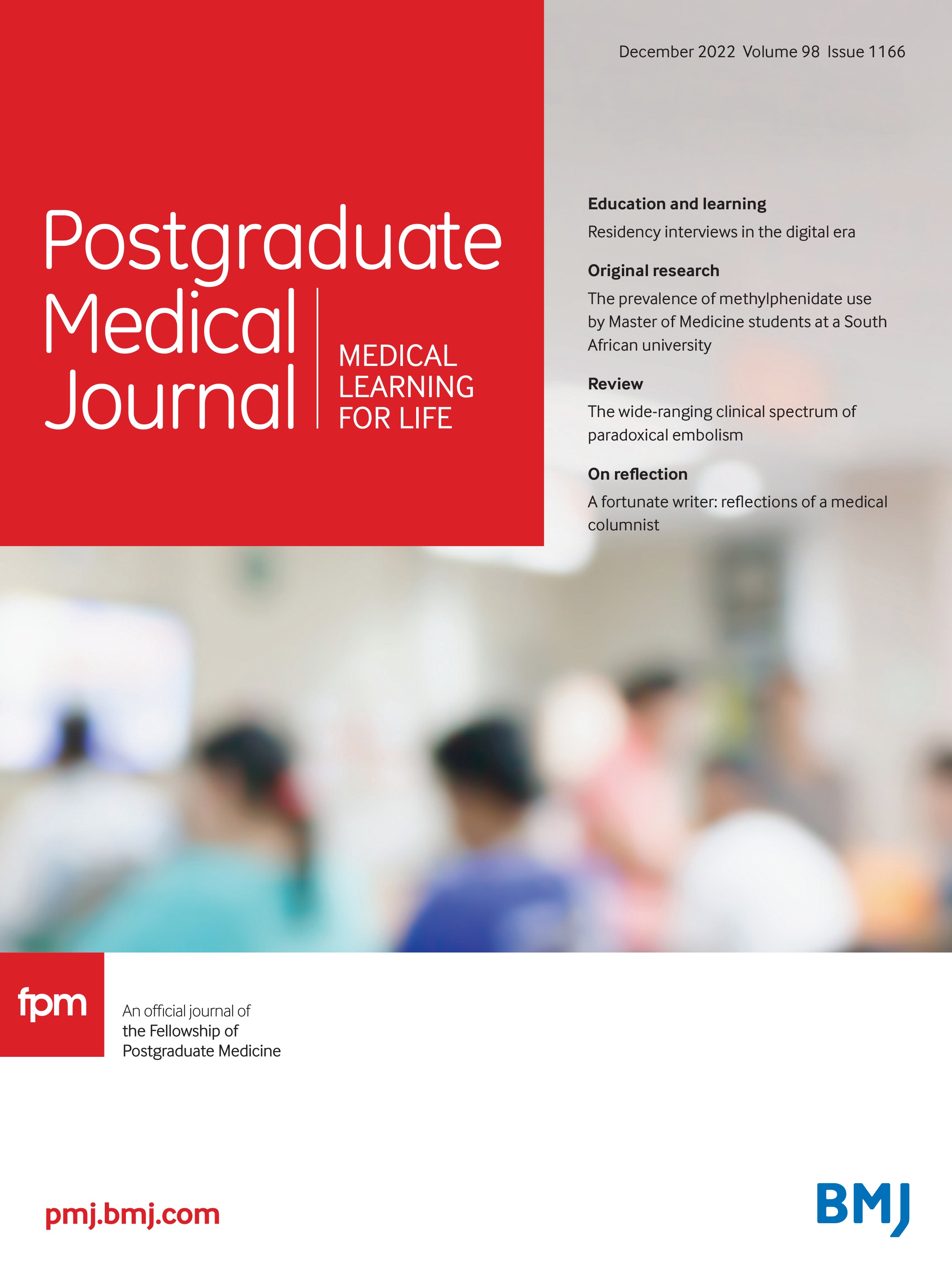Introduction
Smell loss is one of the most common symptoms in COVID-19 infection.1 2 Majority of studies assessed self-reported olfactory dysfunction, while only few studies objectively evaluated patients.3–7 The aim of our study was to evaluate the ability to smell in hospitalised and self-isolated at home patients with COVID-19 and to compare these results with subjective, self-reported olfactory function.
Methods
Study participants
The study was conducted on 55 adult patients with COVID-19 with positive swab/aspirate for SARS-CoV-2 infection, who were either treated in the COVID-19 department (Department of Infectious Diseases, University Medical Centre Ljubljana) or were, due to milder disease course, self-isolated at home. Twenty-four patients with severe course of COVID-19 were tested in hospital towards the end of the acute phase of the disease (hospitalised patients with COVID-19), when patients were stable, not requiring breathing support or oxygen supplementation. Thirty-one patients were tested in an outpatient setting after the end of self-isolation (self-isolated at home patients with COVID-19). The control group consisted of 44 consecutive patients who visited the general neurological outpatient clinic due to complaints such as vertigo, migraine and entrapment nerve syndrome, and who had no suspicion of neurodegenerative condition or symptoms of respiratory infection in the past 2 months. Evaluations were performed between March and May 2020. For more details on methods see Supplementary file 1.
Olfactory evaluation
Self-reported olfactory function was assessed by asking participants to rate their subjectively perceived smell function on the scale from 1 to 10, where 1 means no smelling capability and 10 represents no difficulties. They also rated nasal obstruction on a scale from 1 to 10, where 1 means complete nasal obstruction and 10 represents complete nasal patency. In addition, patients with COVID-19 were asked about presence of parosmia with the question ‘Since becoming ill, did the quality of your smell change, for example can you smell things that are not there’.
Semiobjective, validated smell Burghart Sniffin’ Sticks ‘Screening 12 Test’ (Burghart Instruments, Wedel, Germany) was then used, consisting of 12 everyday scents (table 1).8 9 According to the validated normogram of Burghart Sniffin’ Sticks, normosmic patients required 10, hyposmic 6–10 and ansomic patients 0–5 correct answers. Since smell capability is also dependent on age and sex, each participant was assigned to a percentile range (below 10th, 10th–50th, 50th–90th, above 90th) according to accompanying charts .9
Participants’ characteristics and smell test results
In addition, participants filled in a questionnaire documenting comorbidities, including chronic rhinosinusitis, lung and heart disease, diabetes, hypertension, head injury, cancer, treatment with chemotherapy or radiotherapy, as well as smoking status.
Statistical analyses
IBM Statistical Package for Social Sciences for Windows, Sciences software V.23 (IBM Corporation, Armonk, New York, USA) was used. To assess differences between hospitalised patients with COVID-19, self-isolated at home patients with COVID-19 and controls in smell variables (percentiles, and normosmia, hyposmia and anosmia variables) and comorbidities, Fisher’s exact test was used. Kruskal-Wallis test was used to test differences in the total score (as a sum of correct answers for all 12 scents), and for self-rating assessment of smell and nasal obstruction. Linear regression was used to assess the relationship between olfactory function (total score on Screening 12 Test) and time since COVID-19 infection (number of days from positive swab to testing). Spearman’s correlation analysis was performed to describe association between subjective and semiobjective smell assessment, as well as for comparison of self-rated assessment or total score on Screening 12 Test and self-rated nasal obstruction. Categorical variables are presented as number of cases (percentages), continuous median (IQR—IQR). All tests were two-tailed with a value of p<0.05 considered statistically significant.
Standard protocol approvals and patient consent
All patients provided informed consent for participation in the study.
Results
Smell test results and subjective participants’ perceptions are presented in table 1. Hospitalised patients with COVID-19 correctly determined 6.5 (IQR 5) compared with 10 (IQR 2) in the self-isolated and 11 (IQR 3) in the control group (p<0.001) (hospitalised vs self-isolated and hospitalised vs controls, p<0.001, self-isolated vs controls, p=0.494). There were 66.7% hospitalised patients with COVID-19, 3.2% self-isolated patients with COVID-19 and 15.9% controls who scored below the 10th smell percentile for sex and age (p<0.001) (hospitalised vs self-isolated and hospitalised vs controls, p<0.001; self-isolated vs controls, p=0.130). Linear regression showed significant relationship between the ability to smell and time elapsed from positive swab for SARS-CoV-2 infection (F (1, 51)=14.949, p<0.001, R2=0.222).
Hospitalised patients with COVID-19 self-rated their smelling capabilities with median 5 (IQR 7) compared with 8 (IQR 2) in self-isolated patients with COVID-19 and 9 (IQR 3) in the control group (table 1, p<0.001). The correlation between subjective self-assessment and semiobjective smell testing was non-significant in hospitalised (p=0.423, Spearman’s correlation coefficient=0.176) and self–isolated patients with COVID-19 (p=0.449, Spearman’s correlation coefficient=0.141), while in healthy controls, there was a significant moderate positive correlation (p=0.001, Spearman’s correlation coefficient=0.499). There was no correlation between self-rated smelling capability and self-rated nasal obstruction in both COVID-19 groups (hospitalised COVID-19, p=0.945, Spearman’s correlation coefficient=0.018, self-isolated COVID-19, p=0.147, Spearman’s correlation coefficient=0.267), however they weakly correlated in the control group (p=0.022, Spearman’s correlation coefficient=0.343). In addition, there was no correlation between subjective self-assessment of nasal obstruction and results of ‘Screening 12 Test’ (acute COVID-19 p=0.622, Spearman’s correlation coefficient=0.129,self-isolated COVID-19 p=0.502, Spearman’s correlation coefficient = −0.125, control group p=0.499, Spearman’s correlation coefficient=0.105).
Only 61.8% of patients responded to the question on qualitative changes in smell. Parosmia was present in 4 (33.3%) hospitalised and 11 (50.0%) self-isolated patients (p=0.350) with COVID-19. The three groups did not differ in commorbidities. (table 2), except from allergies and obesity. Participants from the control group had more allergies (11 (25.6%)) compared with self-isolated patients with COVID-19 (3 (10.0%)) and hospitalised patients with COVID-19 (p=0.042). Hospitalised patients with COVID-19 were more likely to be obese (4 (26.7%)) compared with self-isolated patients with COVID-19 and (3 (7.0%)) controls (p=0.011).
Participants’ comorbidities and smoking status
Discussion
The main findings of our study are: (1) Hyposmia or anosmia was present in a vast majority of hospitalised patients (87.5%), with two-thirds of hospitalised patients with COVID-19 being below the 10th percentile for their age and sex, (2) Smell function was significantly more impaired in hospitalised patients with COVID-19 compared with patients with COVID-19 self-isolated at home and control participants, and (3) The correlation between subjective rating of smell and semiobjective testing of smell was unreliable in both hospitalised and self-isolated patients with COVID-19, but not in control participants.
Our finding that a vast majority of hospitalised patients had some degree of smell loss is important. Initial studies, which all used patients’ self-reports, reported that smell loss in patients with COVID-19 may be linked to a milder course of the disease.10–13 This is in sharp contrast with our findings, where 87.5% of patients hospitalised due to a severe COVID-19 course manifested hyposmia or anosmia on olfactory testing. Similarly, Moein et al found that 96% of the hospitalised patients exhibited measurable olfactory dysfunction, with 18% being anosmic. The reason for discrepancy is likely due to the fact that self-reported surveys tend to underestimate the prevalence of olfactory loss in patients with COVID-193 4 6 7 11 14–17 and this may be particularly evident in patients with severe respiratory disease. Indeed, it has been suggested that olfactory dysfunction may be overlooked or forgotten in the setting of severe disease, ventilatory support, and prolonged recovery.4
Smell function was significantly more impaired in hospitalised compared with self-isolated patients with COVID-19 and control participants. This may be explained by time elapsed from contracting infection to olfactory testing, which was longer in the self-isolated group. Indeed, regression analysis confirmed the positive relationship between olfactory score and the time from positive swab for SARS-CoV-2. It is well known that olfactory dysfunction in COVID-19 is largely reversible and that the longer the time since the onset of symptoms, the more likely patients are to have normal olfactory function.17
The absence of correlation between self-rated nasal obstruction and subjective or semiobjective smell assessment suggests that olfactory dysfunction in patients with COVID-19 was not due to nasal obstruction but was rather a consequence of the inflammation in olfactory epithelium.18
Only few previous studies in patients with COVID-19 combined subjective assessment with semiobjective or objective testing in the same patients and noted significant discrepancies between prevalence of self –reported and measured smell loss.2–4 17 As opposed to these studies, where subjective olfactory impairment was ascertained by yes/no (closed question), our subjects rated the ability to smell on a 1–10 numerical scale, which enabled us to perform correlation analysis between subjective and objective scores. We found no association between subjective rating of smell and semiobjective testing in hospitalised and self-isolated patients with COVID-19, while control participants showed a moderate positive correlation. This finding suggests that self-report of olfactory function in patients with COVID-19 is unreliable, even with the use of a more exact rating scale. Indeed, low agreement between self-reported olfactory function and objective testing is not a distinctive feature of COVID-19 smell loss and has been previously described in both young and elderly healthy individuals, as well as in patients with cognitive impairment.19–21 In fact, a study on healthy untrained individuals showed that olfactory self-rating better relates to perceived nasal airway patency than to measurable olfactory function.21
The strengths of our study are the use of a well-validated test of olfactory function that allows for determining different degrees of olfactory dysfunction and inclusion of hospitalised actively ill patients. Limitations are a relatively small sample size and the use of a 12-item test. It has been shown that, in the outpatient setting, test reliability is a function of test length, with shorter odour identification tests being less sensitive to olfactory deficits.22 Nevertheless, short tests may be more appropriate in the hospital setting, as the results of lengthier tests may be affected by inattention and inadequate cooperation of severely ill patients.
Conclusions
Contrary to reports suggesting that the presence of olfactory loss may predict a milder course of disease, our study found that a vast majority of patients with severe respiratory illness had prominent olfactory impairment. Both hospitalised patients with COVID-19 and patients with milder course of the disease that were self-isolated at home scored worse on subjective and semiobjective olfactory testing compared with healthy controls, but their subjective assessment of olfactory function did not correlate with testing results. This finding confirms that self-report of olfactory function in patients with COVID-19 is unreliable.
Main messages
-
Smell loss is present in majority of patients with COVID-19, those with milder course of the disease, requiring only self-isolation at home, as well as in the group of severely ill, requiring hospitalisation.
-
The correlation between self-rated and objective smell evaluation in patients with COVID-19 is poor.
-
Self-report of olfactory function in patients with COVID-19 is unreliable.
Current research questions
What is already known on the subject
Supplemental material
Data availability statement
No data are available.
Ethics statements
Patient consent for publication
Ethics approval
The study was approved by the Republic of Slovenia National Medical Ethics Committee.


